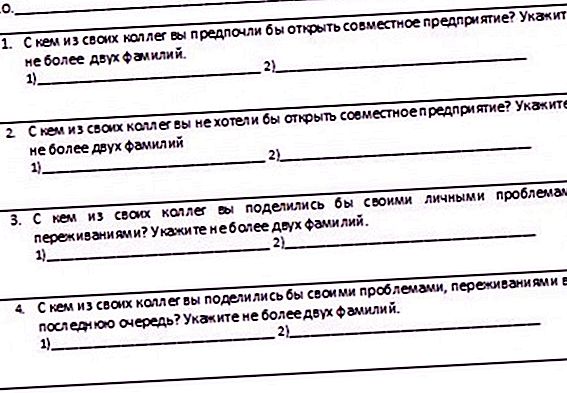Sociometry is one of the most used diagnostic procedures for measuring interpersonal relationships in a group. Sociometry, as defined by its creator Moreno, is an empirical science that quantitatively and qualitatively evaluates interpersonal relationships and experiences associated with the roles that people play in the socio-emotional structure of their group. The essence of the sociometric method is the selection by members of the group of other members of the group for joint activities in any given conditions or specific situation.

Instruction manual
one
The choice of sociometric criterion, i.e. a question asked to all members of the study group in order to clarify the relationship between them.
The criterion should be an indicator, an indicator of these relationships. For example: "Which classmate would you like to practice with?" The criterion should contain a proposal for choice or rejection and should be formulated so that their emotional attitude appears in the reactions of the group members.
2
The choice of procedure for conducting sociometry
Two options are possible here. In the first one, the respondent selects as many persons as he considers necessary.
In the second case, the respondent selects as many people as agreed in advance.
For a group of 20 people, for example, it is recommended to limit the number of elections to 4.
3
Drawing up a sociometric questionnaire (card) to collect information.
It should contain a clear indication of how to fill out a card (if necessary), a restriction on choice and sociometric questions. Sometimes the purpose of the study is summarized in a card.
4
Processing received data.
First, the number of positive and negative elections, as well as the number of mutual elections for each member of the group, is calculated. Further, depending on the purpose of the study, various personal and group indices characterizing the system of relationships in the group are calculated.
For example, you can calculate the positive sociometric status C of any particular group member:
C = number of positive choices received by a member of the group / N-1, where N = group size. The closer C is to unity, the better the ratio of group members to this representative. Or the group index is the reciprocity index G.
G = number of reciprocal positive bonds / N * (N-1), where N = group size. The closer G is to unity, the higher the cohesion of the group. In large groups of 25-35 people, G = 0.20-0.25 should be considered satisfactory.
